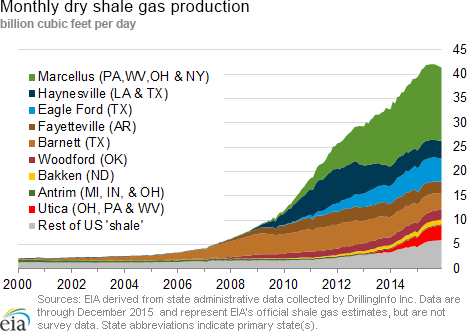In the News:
Natural gas markets weather storm
Though a blizzard brought record daily snowfalls to much of the East Coast this past weekend, price and consumption effects were relatively muted, and less pronounced than the effects of very cold weather the previous week beginning Monday, January 18. In the Northeast, natural gas spot prices remained greater than the Henry Hub spot price but were lower than levels earlier this month.
Residential and commercial consumption began last week at relatively high levels, resulting from very cold temperatures in the Northeast. During the storm, Friday, January 22, to Sunday, January 24, residential and commercial consumption averaged 49.8 billion cubic feet per day (Bcf/d), compared to a five-year (2011-15) average of 53.4 Bcf/d, according to Bentek data. So far in January, total residential and commercial consumption has been very close to five-year average levels, unlike December 2015, when consumption was comparatively low because of much warmer-than-normal weather.
Production remained strong during the storm, even in northeastern areas. Bentek Energy noted that production showed no signs of being affected by the storm, despite several feet of snow being dropped on the area. In the past, low temperatures have caused well freeze-offs.
Pipelines on the East Coast issues operational flow orders, which restrict gas flows, and posted critical notices to prevent imbalances on their systems. Algonquin Gas Transmission and Texas Eastern Transmission restricted gas flowing under interruptible contracts at several points along their systems. Interruptible service refers to natural gas customers (usually industrial consumers or businesses) who pay a lower rate with the possibility that their gas service can be interrupted. Firm transportation customers, on the other hand, generally pay higher rates for guaranteed service even in times of very high demand. Transcontinental Pipeline on Monday partially lifted an operational flow order it issued January 17 in response to cold weather, noting that weather conditions had moderated.
Overview:
(For the Week Ending Wednesday, January 27, 2016)
- Outside of the Northeast, prices generally rose this report week. The Henry Hub spot price rose from $2.14 per million British thermal unit (MMBtu) last Wednesday, January 20, to $2.24/MMBtu yesterday, January 27.
- At the New York Mercantile Exchange (Nymex), the price of the near-month (February 2016) contract increased 3% from $2.118/MMBtu last Wednesday to $2.189/MMBtu yesterday.
- Working natural gas in storage decreased by 211 billion cubic feet (Bcf), declining to 3,086 Bcf as of Friday, January 22. The net withdrawal from storage resulted in storage levels 21% above a year ago and 16% above the five-year (2011–15) average for this week.
- The total oil and natural gas rig count declined by 13 units, with 637 units in service for the week ending Friday, January 22, according to data from Baker Hughes Incorporated. The oil rig count decreased by 5 units to 510, and the natural gas rig count fell by 8 units to 127. This is the lowest recorded natural gas rig count in the Baker Hughes dataset, which goes back to 1987.
- The natural gas plant liquids (NGPL) composite price at Mont Belvieu, Texas, fell by 6.2% to $3.41/MMBtu for the week ending Friday, January 22. The spot prices of all liquids products fell this week, with ethane falling 3.1%, propane falling 8.9%, butane falling 5.3%, isobutane falling 5.2%, and natural gasoline falling 5.9%. The drop in prices most likely relates to the ongoing decline in crude oil prices.
Prices/Demand/Supply:
Natural gas prices flat to slightly up. Outside of the Northeast, price movements were minimal this week. The Henry Hub spot price rose nearly 5% from $2.14/MMBtu last Wednesday to $2.24/MMBtu yesterday, January 27. Despite a major winter storm this past weekend, the Henry Hub spot price did not substantially rise. At the Chicago Citygate, the spot price rose from $2.21/MMBtu last Wednesday to $2.22/MMBtu yesterday. Similarly, west of the Mississippi River, prices were flat. In the Rocky Mountains, the spot price at the Opal Hub in Wyoming opened and closed the report week at $2.07/MMBtu. At the PG&E Citygate in California, natural gas prices also remained flat at $2.46/MMBtu, Wednesday-to-Wednesday.
Northeast prices fall. In major market areas in the Northeast, prices declined substantially this week. At the Algonquin Citygate, which serves Boston, prices fell from $5.55/MMBtu last Wednesday to $3.52/MMBtu yesterday. Boston-area prices fell throughout the week. At Transcontinental Pipeline's Zone 6 trading point serving New York City, prices fell from $3.58/MMBtu last Wednesday to $2.43/MMBtu yesterday. On Friday, heading into the winter storm, prices settled at $3.80/MMBtu, up 30¢ from the previous day.
Marcellus prices flat. Week-over-week, spot prices at major Marcellus trading hubs trended flat. At Dominion South in northwest Pennsylvania, prices began at $1.61/MMBtu last Wednesday and ended the report week at $1.60/MMBtu yesterday. Similarly, on Transco's Leidy Line in northern Pennsylvania, prices fell from $1.40/MMBtu to $1.38/MMBtu Wednesday-to-Wednesday. At Tennessee Pipeline's Zone 4 Marcellus trading point, prices were flat at $1.36 Wednesday-to-Wednesday.
Nymex prices rise. The price of the Nymex February 2016 contract rose from $2.118/MMBtu last Wednesday to $2.189/MMBtu yesterday, when it expired and the March contract moved into the near-month position. The price of the 12-month strip (the 12 contracts between February 2016 and January 2017) rose slightly from $2.399/MMBtu last Wednesday to $2.412/MMBtu yesterday.
Production rises. Dry natural gas production rose 0.4% week over week and is 0.1% greater than the same week last year, according to Bentek data. U.S. imports of natural gas from Canada fell 5.3%. A 17.2% decline in imports to the Midwest offset a 1.3% increase in imports to the West and a 2.6% increase in imports to the Northeast. LNG sendout declined by 14.1%.
Consumption falls. U.S. consumption fell by 5.4%, with the largest decline coming from the residential/commercial sector. Despite a winter storm dumping snow across the East Coast, residential and commercial consumption did not reach the highs it reached in the previous report week, when temperatures were colder. Industrial consumption fell by 2.0%, and consumption of natural gas for electric power generation fell by 0.9%. U.S. exports of natural gas to Mexico fell by 4.2%.
Storage
EIA reports largest weekly net storage pull in the 2015-16 heating season. Net withdrawals from working gas totaled 211 Bcf, exceeding the 5-year (2011-15) average net withdrawal of 170 Bcf by 24%. The withdrawal was almost twice as large as last year's pull for the same storage week. This marks the fourth consecutive week of triple-digit storage withdrawals in the Lower 48 states. Still, working gas levels remain relatively high, with a surplus of 530 Bcf (21%) compared with last year at this time, and 432 Bcf (16%) higher than the 5-year average.
Withdrawals from working gas are generally in line with market expectations. Market analysts predicted working gas draws totaling 207 Bcf for the week, on average. Prices on the Nymex for the March 2016 futures contract gained 3¢/ MMBtu to $2.13/MMBtu in fairly heavy trading, with 815 contracts trading hands immediately following the release of EIA's Weekly Natural Gas Storage Report at 10:30 a.m.
The storage report week is the coldest of the 2015–16 heating season. Temperatures for the report week averaged just less than 32°F, about 1°F below the normal level for this time of year and 6°F below the level reported last year at this time. The cold snap increased heating demand by about 8% over the previous week, with heating degree-days (HDD) totaling 233 for the week. Cumulative HDD remain about 13% below normal thus far in the heating season, which began November 1, despite the colder-than-normal temperatures reported for the storage week.
See also:
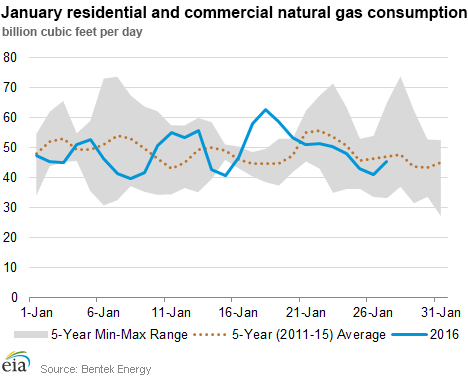
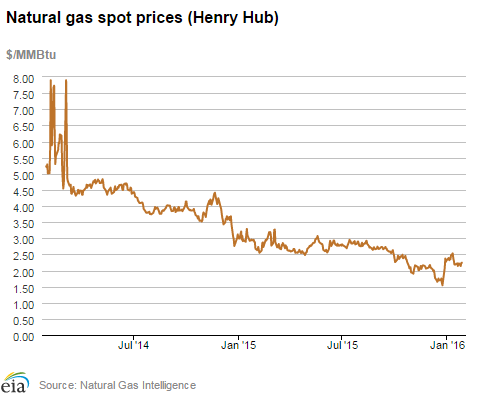
| Spot Prices ($/MMBtu) | Thu, 21-Jan |
Fri, 22-Jan |
Mon, 25-Jan |
Tue, 26-Jan |
Wed, 27-Jan |
|---|---|---|---|---|---|
| Henry Hub |
2.20 |
2.22 |
2.14 |
2.23 |
2.24 |
| New York |
3.50 |
3.80 |
2.68 |
2.52 |
2.43 |
| Chicago |
2.24 |
2.18 |
2.17 |
2.22 |
2.22 |
| Cal. Comp. Avg,* |
2.27 |
2.24 |
2.28 |
2.32 |
2.28 |
| Futures ($/MMBtu) | |||||
| February contract |
2.138 |
2.139 |
2.158 |
2.180 |
2.189 |
| March contract |
2.139 |
2.141 |
2.155 |
2.158 |
2.157 |
| *Avg. of NGI's reported prices for: Malin, PG&E citygate, and Southern California Border Avg. | |||||
| Source: NGI's Daily Gas Price Index | |||||
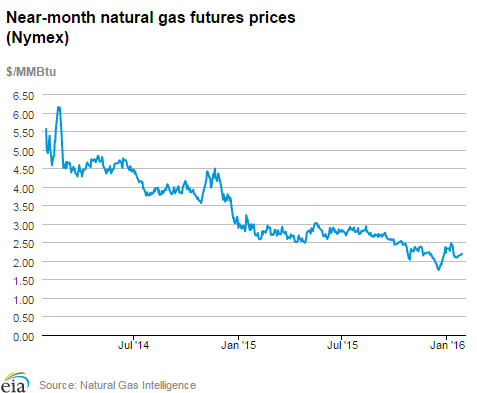
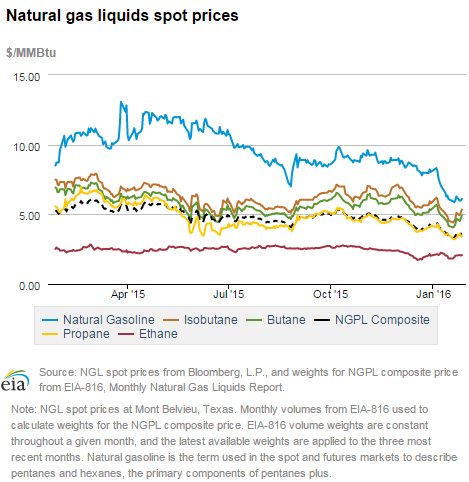
| U.S. natural gas supply - Gas Week: (1/20/16 - 1/27/16) | ||
|---|---|---|
Percent change for week compared with: |
||
last year |
last week |
|
| Gross production | 0.11%
|
0.38%
|
| Dry production | 0.11%
|
0.38%
|
| Canadian imports | 2.34%
|
-5.34%
|
| West (net) | -3.03%
|
1.29%
|
| Midwest (net) | 36.61%
|
-17.18%
|
| Northeast (net) | -22.47%
|
2.57%
|
| LNG imports | 86.86%
|
-14.09%
|
| Total supply | 0.61%
|
-0.21%
|
| Source: BENTEK Energy LLC | ||
| U.S. consumption - Gas Week: (1/20/16 - 1/27/16) | ||
|---|---|---|
Percent change for week compared with: |
||
last year |
last week |
|
| U.S. consumption | 6.4%
|
-5.4%
|
| Power | 14.1%
|
-0.9%
|
| Industrial | 0.5%
|
-2.0%
|
| Residential/commercial | 5.4%
|
-9.1%
|
| Total demand | 7.1%
|
-5.3%
|
| Source: BENTEK Energy LLC | ||
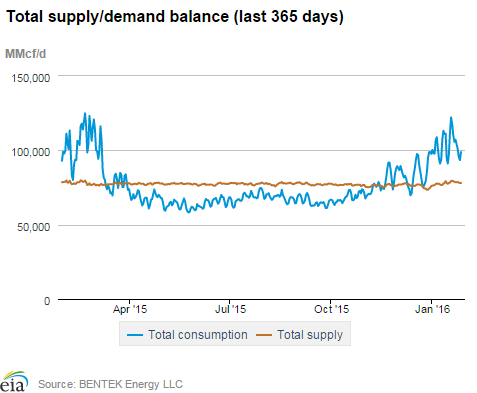
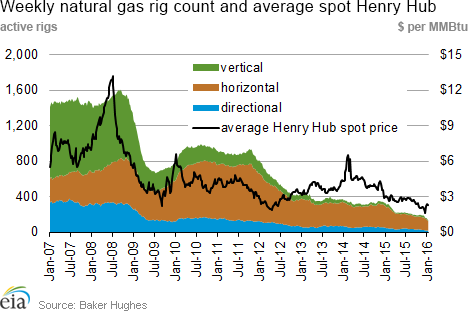
| Rigs | |||
|---|---|---|---|
Fri, January 22, 2016 |
Change from |
||
last week |
last year |
||
| Oil rigs | 510 |
-0.97% |
-61.28% |
| Natural gas rigs | 127 |
-5.93% |
-59.81% |
| Miscellaneous | 0 |
0.00% |
0.00% |
| Rig numbers by type | |||
|---|---|---|---|
Fri, January 22, 2016 |
Change from |
||
last week |
last year |
||
| Vertical | 77 |
0.00% |
-70.16% |
| Horizontal | 500 |
-2.15% |
-59.32% |
| Directional | 60 |
-3.23% |
-58.90% |
| Source: Baker Hughes Inc. | |||
| Working gas in underground storage | ||||
|---|---|---|---|---|
Stocks billion cubic feet (bcf) |
||||
| Region | 2016-01-22 |
2016-01-15 |
change |
|
| East | 695 |
758 |
-63 |
|
| Midwest | 811 |
879 |
-68 |
|
| Mountain | 164 |
170 |
-6 |
|
| Pacific | 273 |
281 |
-8 |
|
| South Central | 1,143 |
1,209 |
-66 |
|
| Total | 3,086 |
3,297 |
-211 |
|
| Source: U.S. Energy Information Administration | ||||
| Working gas in underground storage | |||||
|---|---|---|---|---|---|
Historical comparisons |
|||||
Year ago (1/22/15) |
5-year average (2011-2015) |
||||
| Region | Stocks (Bcf) |
% change |
Stocks (Bcf) |
% change |
|
| East | 600 |
15.8 |
620 |
12.1 |
|
| West | 682 |
18.9 |
699 |
16.0 |
|
| Producing | 134 |
22.4 |
157 |
4.5 |
|
| Total | 2,556 |
20.7 |
2,654 |
16.3 |
|
| Source: U.S. Energy Information Administration | |||||
| Temperature -- heating & cooling degree days (week ending Jan 21) | ||||||||
|---|---|---|---|---|---|---|---|---|
HDD deviation from: |
CDD deviation from: |
|||||||
| Region | HDD Current |
normal |
last year |
CDD Current |
normal |
last year |
||
| New England | 261
|
-14
|
-8
|
0
|
0
|
0
|
||
| Middle Atlantic | 257
|
-6
|
-7
|
0
|
0
|
0
|
||
| E N Central | 328
|
31
|
81
|
0
|
0
|
0
|
||
| W N Central | 359
|
42
|
143
|
0
|
0
|
0
|
||
| South Atlantic | 208
|
26
|
45
|
3
|
-5
|
0
|
||
| E S Central | 218
|
29
|
62
|
0
|
-2
|
0
|
||
| W S Central | 131
|
-8
|
23
|
0
|
-4
|
0
|
||
| Mountain | 213
|
-19
|
28
|
0
|
0
|
0
|
||
| Pacific | 97
|
-23
|
13
|
0
|
-1
|
0
|
||
| United States | 233
|
7
|
44
|
1
|
-1
|
0
|
||
|
Note: HDD = heating degree-day; CDD = cooling degree-day Source: National Oceanic and Atmospheric Administration | ||||||||
Average temperature (°F)
7-Day Mean ending Jan 21, 2016
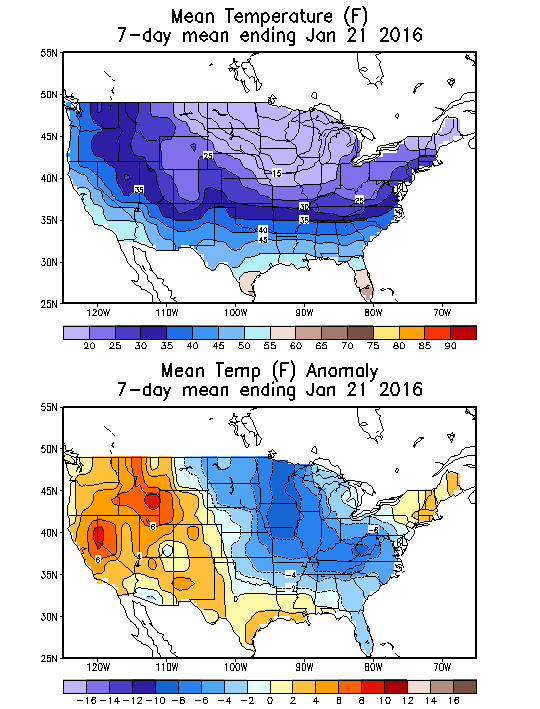
Source: NOAA/National Weather Service
Deviation between average and normal (°F)
7-Day Mean ending Jan 21, 2016

Source: NOAA/National Weather Service

